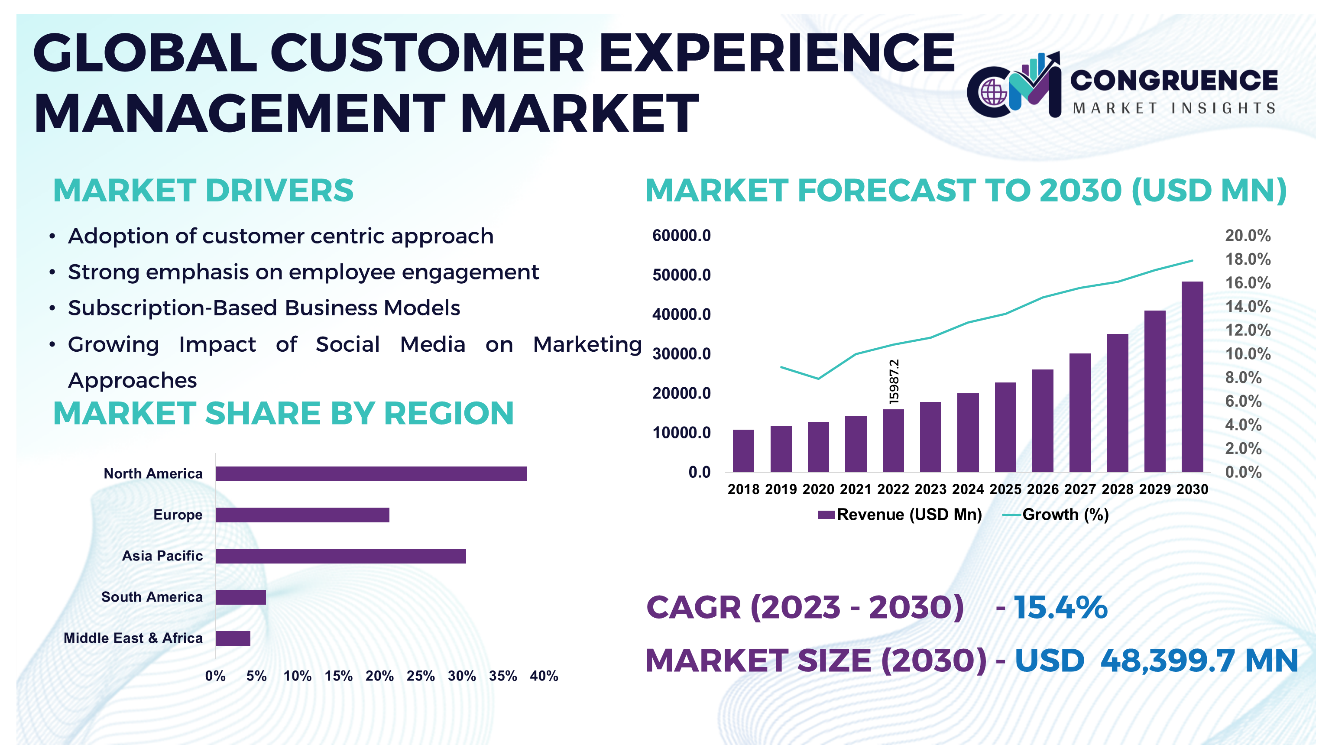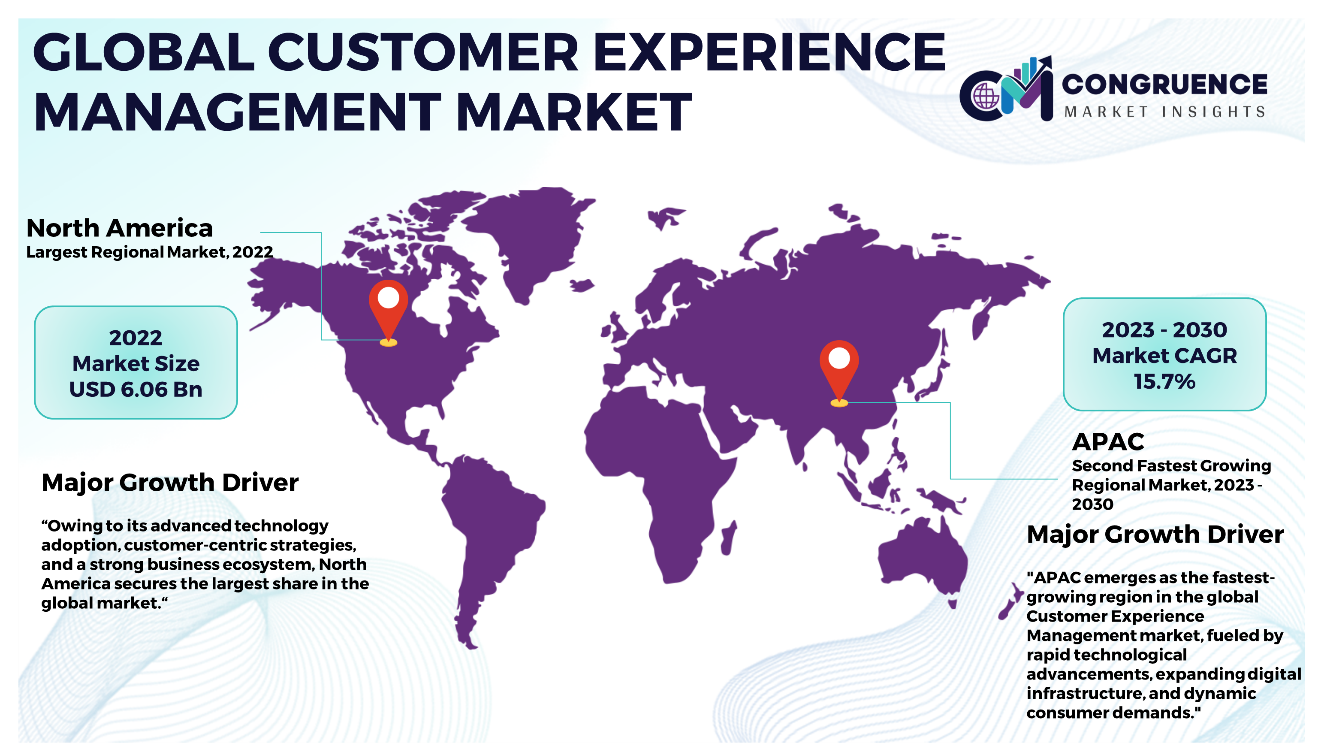Reports
The Global Customer Experience Management Market was valued at USD 15,987.2 Million in 2022 and is anticipated to reach a value of USD 48,399.7 Million by 2030 expanding at a CAGR of 15.4% between 2023 and 2030.
The Global Customer Experience Management (CEM) market undergoes continuous evolution, emphasizing the enhancement and streamlining of customer interactions across various touchpoints. CEM involves a comprehensive strategy that leverages technologies, analytics, and processes to craft personalized and seamless customer experiences. Businesses spanning IT & Telecom, Retail and E-Commerce, Automotive, Media and Entertainment, Tours and Travel, and Education recognize the utmost significance of customer satisfaction and loyalty for sustained growth.
Key components in the CEM landscape encompass advanced analytics providing actionable insights, Voice of the Customer (VoC) initiatives for direct feedback, and the integration of innovative technologies such as artificial intelligence and machine learning for personalized engagements. Both large enterprises and Small and Medium-sized Enterprises (SMEs) actively adopt CEM strategies, tailoring them to their respective scales and operational needs. The focus extends beyond mere issue resolution to the proactive identification and alleviation of customer needs, preferences, and pain points.
Within this dynamic milieu, major players like Adobe Systems, Oracle Corporation, SAP SE, and Salesforce.com continually innovate and compete, offering comprehensive CEM solutions customized to diverse business requirements. As customer expectations evolve and digital transformation accelerates, the CEM landscape remains at the forefront, reshaping the ways in which businesses globally establish connections and engage with their customers.

Customer Experience Management Market Major Driving Forces
Adoption of customer centric approach: An increasing number of companies are acknowledging the strategic significance of adopting customer-centric approaches. CEM enables businesses to synchronize their strategies with customer needs, thereby enhancing loyalty and satisfaction.
Strong emphasis on employee engagement: Recognizing the correlation between employee satisfaction and customer experience, businesses are directing their focus on employee engagement to ensure motivated staff members who deliver excellent customer service.
Subscription-Based Business Models: The prevalence of subscription-based models underscores the enduring relationship with customers. CEM becomes instrumental in sustaining and enhancing customer satisfaction throughout the entire subscription lifecycle.
Growing Impact of Social Media on Marketing Approaches: Social media platforms amplify the voices of customers, allowing positive experiences to be shared globally and negative ones to potentially go viral. CEM assists businesses in effectively managing and responding to customer sentiments on social channels.
Customer Experience Management Market Key Opportunities
Real-Time Customer Feedback: Implementing real-time feedback mechanisms to capture customer sentiments promptly, allowing businesses to address issues promptly and enhance positive interactions.
Multi-Channel Integration: Integrating and optimizing customer experiences across multiple channels, ensuring consistency and seamlessness throughout the customer journey.
Employee Training and Engagement: Investing in employee training programs and engagement initiatives to ensure frontline staff is equipped to deliver exceptional customer service and support.
Mobile Experience Enhancement: Enhancing mobile experiences to cater to the growing number of users accessing services and products through smartphones and tablets.
Artificial Intelligence in Customer Service: Implementing AI-driven chatbots and virtual assistants for efficient and round-the-clock customer support, enhancing overall customer satisfaction.
Customer Experience Management Market Key Trends
· Businesses are increasingly directing their efforts towards hyper-personalization, employing advanced data analytics and AI to customize experiences at an individual level, aligning with distinct customer preferences and expectations.
· The need for seamless experiences across multiple channels is consistently on the rise. Companies are embracing omnichannel strategies to ensure uniformity and cohesion in customer interactions across diverse touchpoints.
· VoC analytics is undergoing heightened sophistication, enabling businesses to delve deeper into customer sentiments, preferences, and feedback. This data-driven approach informs strategic decision-making for an enhanced level of customer satisfaction.
· The integration of artificial intelligence (AI) into customer service is witnessing an upward trajectory, as businesses deploy chatbots and virtual assistants to deliver immediate and efficient support, thereby augmenting the overall customer experience.
· AR and VR technologies are being harnessed to craft immersive and captivating customer experiences, particularly in industries like retail and e-commerce where visualization holds paramount importance.
· Predictive analytics is playing a pivotal role in forecasting customer behaviors, empowering businesses to engage proactively and address potential issues before they escalate, nurturing more positive customer relationships.
Region-wise Market Insights
North America accounted for the largest market share at 37.9% in 2022 whereas, Asia Pacific is expected to register the fastest growth, expanding at a CAGR of 15.7% between 2023 and 2030.

The dynamics of the global Customer Experience Management (CEM) market vary across regions. In North America, the market remains robust, driven by the widespread adoption of advanced technologies and a strong commitment to delivering personalized customer experiences. North America commands a substantial market presence, with a significant contribution from the United States.
Across Europe, the CEM market demonstrates steady growth, propelled by a dedicated focus on improving customer satisfaction and fostering loyalty. The region includes key participants such as the United Kingdom and Germany. The Asia-Pacific region witnesses a flourishing CEM market, propelled by rapid digital transformation and escalating customer expectations. China and India emerge as pivotal growth markets. In Latin America, there is a noticeable surge in interest in CEM solutions, propelled by a growing awareness of the profound impact of customer experience on business success. Brazil and Mexico demonstrate significant adoption. The Middle East and Africa showcase a developing CEM landscape, marked by a heightened recognition of the strategic importance of customer-centric approaches. Notable leadership comes from the United Arab Emirates and South Africa.
Segment-wise Market Analysis
· Cloud-based deployment dominates the global Customer Experience Management market, providing businesses with flexibility, scalability, and cost-effectiveness. With the seamless accessibility of data and applications, companies can swiftly adapt to evolving customer needs. The cloud model's efficiency in delivering real-time insights, enhancing collaboration, and ensuring swift updates positions it as the preferred deployment choice, driving its widespread adoption across industries.
· Retail and E-Commerce stand as dominant end-use industries in the global Customer Experience Management market. The sector prioritizes CEM solutions to optimize online and in-store experiences, enhance customer satisfaction, and drive loyalty. Utilizing CEM technologies enables retailers to gain actionable insights, personalize interactions, and stay competitive in a dynamic market, solidifying Retail and E-Commerce's central role in the CEM landscape.
Market Competition Landscape
The Customer Experience Management (CEM) market is marked by intense competition, with major players like Adobe Systems, Oracle Corporation, SAP SE, and Salesforce.com leading the way in shaping the competitive landscape. Adobe Systems, known for its innovative software solutions, has made significant strides in CEM, providing a comprehensive suite of tools to enhance customer interactions. Oracle Corporation, a global technology giant, has solidified its position by offering end-to-end CEM solutions, leveraging data analytics and cloud-based platforms. SAP SE, a leader in enterprise software, maintains a strong presence in the market with its CEM offerings, focusing on data-driven insights and personalized customer engagement. Salesforce.com, a prominent player in customer relationship management (CRM), has expanded its influence in the CEM space, emphasizing cloud-based solutions and AI-driven technologies to maintain a competitive edge. Together, these key players shape market dynamics, fostering innovation and driving the adoption of advanced CEM strategies. The global CEM market size reached a significant figure, indicating the increasing importance of CEM in businesses worldwide. The market's competitive nature has led to continuous advancements, with companies investing in research and development to stay ahead. The competitive landscape is further influenced by strategic partnerships, mergers, and acquisitions, reflecting the ongoing efforts of companies to offer comprehensive and cutting-edge CEM solutions. As businesses strive to excel in this competitive environment, the market is poised for further evolution, presenting both challenges and opportunities for industry players.
Key players in the global Customer Experience Management market implement various organic and inorganic strategies to strengthen and improve their market positioning. Prominent players in the market include:
· Adobe
· IBM Corporation
· SAP SE
· Oracle
· Genesys
· Sitecore
· Teradata
· Avaya LLC
· Freshworks Inc.
· NICE
· Qualtrics
· Verint Systems Inc.
· Microsoft
· Salesforce, Inc.
|
Report Attribute/Metric |
Details |
|
Market Revenue in 2022 |
USD 15,987.2 Million |
|
Market Revenue in 2030 |
USD 48,399.7 Million |
|
CAGR (2023 – 2030) |
15.4% |
|
Base Year |
2022 |
|
Forecast Period |
2023 – 2030 |
|
Historical Data |
2018 to 2022 |
|
Forecast Unit |
Value (US$ Mn) |
|
Key Report Deliverable |
Revenue Forecast, Growth Trends, Market Dynamics, Segmental Overview, Regional and Country-wise Analysis, Competition Landscape |
|
Segments Covered |
· By Offering (Solution, and Service) · By Deployment Model (Cloud Based, and On-Premise) · By Organization Size (Large Enterprise, and SMEs) · By End Use Industry (IT & Telecom, Retail and E-Commerce, Automotive, Media and Entertainment, Tours and Travel, Education, and Others) |
|
Geographies Covered |
North America: U.S., Canada and Mexico Europe: Germany, France, U.K., Italy, Spain, and Rest of Europe Asia Pacific: China, India, Japan, South Korea, Southeast Asia, and Rest of Asia Pacific South America: Brazil, Argentina, and Rest of Latin America Middle East & Africa: GCC Countries, South Africa, and Rest of Middle East & Africa |
|
Key Players Analyzed |
Adobe, IBM Corporation, SAP SE, Oracle, Genesys, Sitecore, Teradata, Avaya LLC, Freshworks Inc., NICE, Qualtrics, Verint Systems Inc., Microsoft, and Salesforce, Inc. |
|
Customization & Pricing |
Available on Request (10% Customization is Free) |
